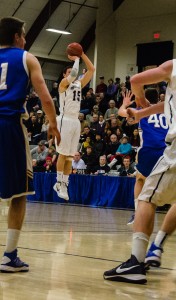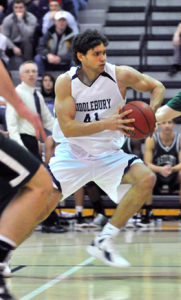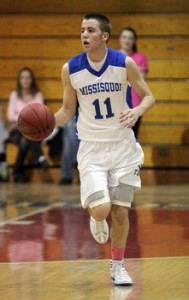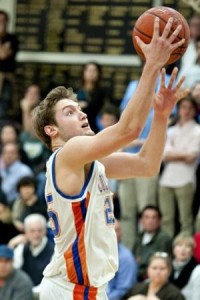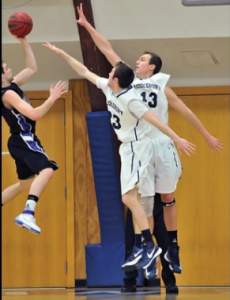We’ve covered a lot in the past two days, but there were a couple of thoughts and questions that needed to be discussed further. The following is our attempt to answer those questions and share our final thoughts about the team before the season begins.
Who do you project to be day one starters? Who are your first four off the bench?
DAMON:
G – Henry Pendergast
G – Joey Kizel
F – Hunter Merryman
F – Dylan Sinnickson
C – Jack Roberts
Bench – Nate Bulluck, Matt Daley, Matt St. Amour, Chris Churchill
JEFF:
G- Henry Pendergast
G- Joey Kizel
G- Nate Bulluck
F- Hunter Merryman
C- Jack Roberts
Bench – Matt St. Amour, Matt Daley, Dylan Sinnickson, Jake Nidenberg
JEFF: Kizel is the obvious start. I put Bulluck next to him because I think Jeff Brown likes him for his experience and defense. Next it came down to Pendergast or Sinnickson for me, and I took Pendergast because I don’t think Bulluck and Kizel are enough in terms of ball-handling, at least early in the season. That said, I don’t want Pendergast playing too much. Even though they are looking to move Kizel off the ball this year, at this early juncture the team needs an experienced distributor so that everybody else can focus on more complementary roles. On the bench, I think Sinnickson will be the first substitution, probably for one of the guards, to test out a bigger lineup. Jake Brown would be in the discussion but he sustained an injury and is likely out for this tournament. The same goes for James Jensen. St. Amour gets rotation minutes right away because of his offensive maturity, while Daley and Roberts could essentially split minutes at center. Are we assuming too much in regards to the talented by unproven duo of Matts?
DAMON: We’re one paragraph into this conversation and I’m already backtracking. This isn’t a good sign of things to come. You’ve sold me on your Bulluck argument, particularly because Sinnickson is working his way back from a year away from basketball and then an injury this fall that cut his football experiment short. What can I say—he made a pretty compelling case to start on our radio show a couple of weeks ago. It wouldn’t be the first time I’ve overreacted to a compelling pitch. The ball-handling concern is a fair one and Nate has really improved in that department. Given the departure of Jake Wolfin and Nolan Thompson, Bulluck probably realized that improving his dribbling and trying to assume Thompson’s third-guard role in the offense was his best avenue to more minutes—smart.
And no, we’re not assuming too much from the pair of Matts. I think we’re going to see a lot of different lineups in today’s game and I would imagine both of those guys will be featured heavily. You and I both agree that if Middlebury is going to make a deep tournament run (we’ll get to that in a moment) Daley and St. Amour will need to have big seasons. Obviously the talent is there in bundles, the question is whether one or both can realize it. I like your Nidenberg pick—he has had a great preseason—but I think Churchill will get a good look in this game. Coach Brown has to figure out what he has at the ‘5’ and determining the rotation between Roberts, Daley and Churchill is one of the most pressing questions.
•••
What about halfway through the NESCAC season? Does the starting five change, assuming good health? The top reserves?
JEFF:
G – Jake Brown
G – Joey Kizel
F – Hunter Merryman
F – James Jensen
C – Matt Daley
Bench- Matt St. Amour, Nate Bulluck, Dylan Sinnickson, Jack Roberts
DAMON:
G – Joey Kizel
G – Matt St. Amour
F – James Jensen
F – Hunter Merryman
F – Matt Daley
Bench – Jake Brown, Dylan Sinnickson, Jack Roberts, Connor Huff
DAMON: So you’ve gotten caught up in the Jake Brown hype, huh? In all seriousness, I think we have a similar outlook for JB, but I see St. Amour starting over him because a Kizel, Brown starting backcourt is, uh, vertically limited. Also, I think ultimately, if Daley and St. Amour win starting jobs, Middlebury will have enough offense on the floor to move Kizel back onto the ball, which is where I think he is most effective and will allow him pick his spots late in games. Speaking of which, the lineup Jeff Brown uses to close games will be equally intriguing. If Kizel is going to transition late in games and look to score more, it may require either Brown or Henry Pendergast (who neither of us have in our first four off the bench) to be in the game in order to add an extra ball handler. The interesting question to me is who they would replace—likely either St. Amour or Merryman. If it comes down to the two of them, my bet is St. Amour stays on the floor, but Sinnickson may also work his way into the closing lineup, too. Too many closing options is anything but a bad problem, though. Jeff Brown will be able to determine his lineup based on how his team matches up defensively and ride the hot hand offensively.
If there’s a bench guy Middlebury fans should watch this season, it’s Connor Huff, in my opinion. Everytime Huff takes the floor, whether it’s in practice or a game he makes things happen. He’s a hard worker and a good shooter, who can score from anywhere inside the three-point line. If he gets an opportunity early, I think he’ll stick.
JEFF: We both are projecting some high potential guys to improve, which is what this season will depend upon. One guys whose role is going to be interesting to watch is Jack Roberts. He could take a senior year jump after starting as a junior, but I actually think the style of play of this team (fast-paced, stretch the court) might not fit well with his game. He could turn into an opponent-specific stopper at center. Against most D-III teams, Jensen, Sinnickson, and Daley are enough to hold up defensively down low. One thing I love about this rotation is the potential for Kizel, St. Amour, Merryman, and Daley to all be on the court together. Each is an excellent outside shooter for his position, and a distributor like Jake Brown or Henry Pendergast could drive and kick to whomever the defense dictated. Sinnickson and Jensen are also strong enough in the mid-range to mesh with that strategy.
•••
Is this team going to make the NCAA Tournament?
JEFF: Yes. One thing that we often forget is how dominant the NESCAC is. I see no problem with four teams going to the tournament, and I don’t see Middlebury finishing below fourth in the conference, which would probably mean six losses before tournament play (Alvernia, St. Mary’s, Tufts, Williams, Amherst, Conference semifinals). If this is the floor (or a slight variation of it), given that those losses will most likely have come against five tournament teams, they will beat out the at-large candidates from weaker conferences. Even if the complementary players underwhelm, Joey Kizel and a decent supporting cast should be enough.
DAMON: This question makes me far more nervous than it should. Obviously Middlebury is a more established team than Wesleyan was in 2011-12, but the Cardinals went 20-6 (7-3) and advanced to the NESCAC semifinals that year, but missed out on an NCAA Tournament bid. Gun to my head—or deadline advancing—I’ll say they make it, if only because I think Jeff Brown is a tremendous coach and there is a ton of talent on this roster, which goes 14 players deep. Of those 14, Middlebury realistically needs eight to nine players to have solid to spectacular seasons to make it’s seventh consecutive NCAA Tournament. So yeah, I think they’ll make it, but I also get the feeling we’ll be all kinds of nervous watching the selection show come March.
•••
Where will Joey Kizel rank among the recent Middlebury greats when his career is over?
JEFF: Let’s put Ben Rudin and Tim Edwards aside because we both would probably put Joey above them without a fair treatment, since they came before our time. The Middlebury greats who we are talking about are Andrew Locke, Ryan Sharry, Nolan Thompson, and Jake Wolfin. Those are the players who defined the program over the past four years. Locke was the most breathtaking to watch, Sharry was the best offensive player, Wolfin mastered the art of the point guard, and Thompson was the best shutdown defender we’ll ever see. Right now, because Sharry and Thompson had more complete games, I’m saying they are the top two, then Kizel, then Locke and Wolfin. Kizel belongs there right now because in addition to his remarkable scoring, he has singlehandedly won this team more games over the past two years than anyone else. We are guaranteed some more vintage Kizel games this season, as he is going to have to start putting the team on his back in a few hours, and might not stop until March. He is within range of the top of the list.
DAMON: You’re not really addressing the question. Yeah, right now I’d put Thompson and Sharry ahead of Kizel, but to me, when his career is over—short of a truly disappointing senior season—Joey is at the top of this list. And you can throw Rudin, Edwards and pretty much whomever else you want onto that list. Other guys may finish with gaudier numbers than Joey, but more than any player I’ve ever been around only one thing matters to Kizel: whether his team wins the final game of the season. When we look back on his career and all of the awesome, incredible—and I mean awe inspiring and truly unbelievable—things he did during his career at Middlebury, there’s no way anyone else tops him on that list. You baited me with this question because I’m not sure there’s another athlete across any sport at any level I’ve enjoyed watching more than Joey Kizel. (This is just between you and me right?)
JEFF: Sure thing. Here’s why it’s hard for me: Sharry might have been the best player in the country his senior year, putting up totally obscene numbers that reflected on-court dominance: 18.8 ppg, 10.3 rpg, 2.0 apg, 2.0 bpg, 1.0 spg, and 61/43/67 shooting splits. If that doesn’t make you think twice, look at those numbers again. You can nitpick some of his performances, but this program will never have somebody who can do it all like Sharry could. And Thompson might challenge Kizel’s claim to the greatest will to win, in addition to being an underrated offensive player and otherworldly on defense. All I’m saying is, let’s be cautious—we’re dealing with some big time claims. But a scoring jump and a few more magic moments from Kizel this year, and I’ll happily concede.
•••
How much will losing Nolan Thompson’s defense hurt this team?
DAMON: This is a difficult question to answer because it depends so much on whether Middlebury evolves into an explosive offensive team that relies on forcing turnovers and getting out in transition. Either way, though, I think Middlebury will noticeably miss Nolan’s defense, in much the same way they’ve missed Andrew Locke’s presence inside the past two seasons. Think about how many times we’ve thought to one another, “It would be nice to have Andrew in this game.” Well, we’ve already started doing that with Nolan, who would be all kinds of helpful this weekend against an undersized, guard-heavy Alvernia team. And while Jensen should return to the court soon at full health, he’s really the only guy who can comfortably match up against the plethora of wings in the NESCAC and beyond. There will also be a fair number of games (Williams comes to mind, in particular) when Jeff Brown is going to have to pick his poison because he doesn’t have the benefit of two defenders who can shut down guards, wings and forwards. Where this team may mitigate some of the loss of Nolan is with Jake Brown, who’s going to be a really good defender and, perhaps more importantly, plays the style of defense that is perfect for this team. Nolan was a lock-down defender who made it impossible for his man to move sometimes, let alone dribble, pass or score. Jake might not be as adept keeping his man in front of him, but he will also force more turnovers, which will let this team run the floor. I’m already so excited to watch him pick guys’ pockets and find Daley or Sinnickson running the floor. They may not win as many games as we want, but there are going to be dunks this year.
JEFF: Well wins and dunks have a pretty even exchange rate in my mind, so that’s a nice consolation. (This statement will be less funny and more sad if this team doesn’t find a defensive identity.)
I’ve never experienced anything as a fan like what we experienced with Thompson. The fact that the first thing that we would do when we were looking at a future opponent is look for their best scorer’s height, and if it was under 6’6” stop worrying about him, is amazing. And it wasn’t hubristic on our part either. Thompson shut down all of these guys, usually surpassing our expectations, and forcing opposing offenses to make due with their other four players. In Division III, where so many teams are built around one superstar—often a score-first guard—that was a pretty incredible luxury. We can hope that this year’s defense is opportunistic, but I’m less optimistic than you. Are they athletic? Yes, but I’m not sure this team has many fundamentally strong defenders. This will be exposed, and we will see a lot more great individual scoring performances from opponents this year than we are used to.
•••
Who will be the second leading scorer, behind Kizel?
DAMON: Ugh, you’re baiting me again. I should know better than this, but the season is less than 24 hours away and I’m giddy. Matt St. Amour will be the second leading scorer after Kizel. (This is either going to look very smart or very stupid five months from now.) I think St. Amour will slowly work his way into the rotation and the starting lineup, but defer to his teammates early in the season. There’s going to be a moment, though, sometime this season when St. Amour realizes he can play a big role on the offensive end. And while he may not be able to consistently beat his man off the dribble, and there will be times when looks like a freshman, I think he’ll have a couple of games where his potential becomes his production and St. Amour goes off.
To temper my enthusiasm slightly, I don’t see a non-Kizel player averaging more than about 12 points per game and I think shots and points will be pretty evenly distributed across the rotation. So it’s not so much that I think St. Amour will take the NESCAC by storm, but that he’ll outproduce his teammates in a balanced Middlebury offense.
JEFF: St. Amour is a great shooter, but adjusting to the speed of the college game will be tough, and he might not play enough minutes to score so much right away. Here’s my ranking of the most likely players to finish second in scoring:
1) Hunter Merryman – 8.3 points in 15 minutes per game last year; if his outside shooting is on, he will certainly put up double digits.
2) James Jensen – I agree that the scoring will be evenly distributed, and Jensen will get the second-most minutes on the team. He can finish around the hoop, and get to the line frequently.
3) Dylan Sinnickson – Lest we forget, he scored at a torrid rate his freshman year; he might not have a complete game yet, but he produces when he is on the floor.
4) Matt St. Amour – I love his shot, and I love his offensive approach, but I still have concerns about the transition.
5) Matt Daley – If he starts early (which I think is just a 25-30% chance), he moves to first on the list. He can finish down low, run the break, and stretch out to beyond the arc.
DAMON: I’m glad you were more reasonable in your response than I was. The readers definitely appreciated your more well-rounded response to the question. I do think your critique of my response is fair and if not St. Amour, then I agree that Merryman is the most likely alternative to follow Kizel in points per game. Again, the reasoning behind my St. Amour pick isn’t so much that I don’t believe in the other guys you listed as much as I think they’re all going to score in the 8-12 points per game range, opening the door for St. Amour, if he makes the transition. To that point, I think the NESCAC, while full of gifted athletes, is a fairly easy league for a player of St. Amour’s caliber to transition into. It won’t always be pretty, but I don’t see any reason why St. Amour can’t have a Matt Hart type season, taking fewer shots, but scoring with greater efficiency. Maybe I’m blindly naive, but I’m going with my instinct until I see something that tells me otherwise.
•••
What can we expect from Matt St. Amour and Jake Brown over the course of their careers?
JEFF: I think these two both start for three years, St. Amour scores 1,200 points, and both are first-team all-league guards their senior season. Brown already seems in his element with the upperclassmen, and just makes things happen on both ends of the court. St. Amour needs to build on his game to be a top scorer but is starting in a better place offensively than any freshman in recent memory. Let’s not discount the two underclassmen who will be sharing the backcourt with them, Henry Pendergast and Bryan Jones. That nucleus can accomplish a lot in the coming years.
DAMON: My amour for the freshman class is forte as the French would say. And since I’ve already outed myself as a member of the MSA fan club, I’ll keep plowing forward (jump on now, Panther nation). I think Matt St. Amour will be discussed similarly to Joey Kizel by the next version of us (do you think they’ll be cooler than we are?). I think St. Amour is a future All-American, NESCAC scoring champion and when his career is all said and done, his name is going to be very close to the top of Middlebury’s all-time scoring list. Brown, meanwhile, has a chance to be special, too. He’s a true point guard, with great ball skills and could be a future NESCAC Defensive Player of the Year candidate. Offensively, he has shades of Shasha Brown in his game, though I think he’ll score fewer points (and take fewer bad shots, too) and accumulate more assists. More than anything, I think the two of them will be a nightmare backcourt for opposing teams to prepare for and matchup with. Throw Bryan Jones and Pendergast into the mix and you have the making of a truly special backcourt that could rival the Wolfin, Thompson, Kizel trio.
JEFF: If there is a next version of us, I can only hope they are cool enough to not refer to Panther nation in its common noun form. And prudent enough to never try to defend themselves logically against critics.
DAMON: They’re already a lost cause.
•••
So what do you make of this team? What are your final thoughts before the season starts?
JEFF: On the one hand, this program finally made it to elite status after years of mediocrity, and these recruiting classes reflect that prestige. On the other hand, we just experienced what felt like the program’s golden years, with some irreplaceable players, and most guys on this team haven’t accomplished anything. This reflects a tension between big-picture high expectations and some relatively low short-term expectations. I have little doubt that Middlebury will compete at a national level as long as Jeff Brown heads the program. As of right now, I won’t be surprised if the growing pains are too much for them to match recent success. Middlebury fans, of late, are used to total dominance. Over the past five years, this team has lost 10 regular season games. Connecticut College lost that many games in conference play last winter. We’re going to experience some uncharacteristic losses, and might have to recalibrate our expectations if certain players don’t emerge. Having said that, I already like a lot about this team, and with Joey Kizel and Jeff Brown at the helm, there aren’t many programs in the country I would bet on against these guys.
DAMON: Honestly, this season could go in so many different directions, very few of which would surprise me. I’ve gone back and forth on this team a number of times during the course of writing the preview and I’m still not particularly confident I have a great feel for where things are headed this season (but please, don’t stop reading!). We laughed about how positive my player breakdowns were, but that’s because it’s very difficult to critique potential. If little to none of this team’s potential is realized, it could be a disappointing season, where Middlebury falls flat and fails to make the NCAA Tournament. I’m (sort of) prepared for that possibility. The freshmen could all be a year away—despite what I’ve expounded over the thousands of words I’ve written about the team—and without significant contributions from St. Amour and/or JB, it’s going to be hard for this Middlebury team to make a deep tournament run, or even an appearance. But again, I’m hanging my hat on the last time a Jeff Brown team was in this situation—Jake Wolfin and Nolan Thompson’s freshman year, when an understated recruiting class—only Wolfin was expected to contribute—replaced then the most decorated senior class in program history. I think Brown and St. Amour can make similar impacts (obviously in different ways) to Wolfin and Thompson, particularly playing alongside Kizel, who is going to make life easier for both of them on the floor. And yeah, there may be a loss to Tufts or Bowdoin along the way—this team certainly won’t be as consistently excellent as the 2009-13 teams—but I do think, come March, if things go well, this team’s ceiling is just as high as any of those teams. For now, I’m going to forget how many conditionals were in that statement and enjoy the start of the basketball season. Regardless of where this season ends up, it’s so good to have Middlebury basketball back in our lives.
